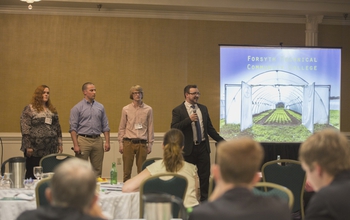First, second place projects address renewable energy, biofuels
 The Forsyth Technical Community College team proposed a method to modernize greenhouses. Credit and Larger Version |
June 24, 2016
A team of expert judges has selected Forsyth Technical Community College’s team as first place and Normandale Community College and Virginia Western Community College as tied for second place in the 2016 Community College Innovation Challenge (CCIC), which invited teams to propose innovative, research-based solutions to challenges at the nexus of food, energy and water systems.
The National Science Foundation (NSF), in partnership with the American Association of Community Colleges (AACC), developed the CCIC competition as a way to foster the development of crucial innovation skills among students in one of the nation’s most significant academic sectors. Community colleges play an important role in developing America’s technical workforce, in part by involving groups traditionally underrepresented in science, technology, engineering and mathematics (STEM) education and careers.
“The Community College Innovation Challenge presented these students with real-world questions that the scientific community is working to answer,” said Joan Ferrini-Mundy, NSF assistant director for Education and Human Resources. “It has been gratifying to see how enthusiastically all of this year’s participants have responded to that challenge. These winning teams are emblematic of the kinds of quality entries we received.”
The 2016 CCIC focused on the Innovations at the Nexus of Food, Energy and Water Systems (INFEWS) program, an NSF priority that seeks new ways to help society deal with growing resource demands.
“This year’s challenge linked an important and growing area of research with a vital part of the scientific and technical education system,” said Susan Singer, director of NSF’s Division of Undergraduate Education. “Community colleges are strong members of the STEM community, and these CCIC participants demonstrate the kind of innovation and ambition their students have to offer.”
A group of 10 CCIC finalists, who submitted videos describing their proposals, attended a four-day innovation “boot camp” this week, during which they received feedback on their presentations and met with experts on subjects including team-based design, communicating the value of innovation, and transitioning research to commercialization.
A panel of expert judges selected the winners Thursday: Rathindra DasGupta, former NSF Innovation Corps program director and current innovation and entrepreneurship consultant; Denise Eblen, deputy director of the National Institute of Food and Agriculture; Morven McLean, executive director of the Center for Environmental Risk Assessment at the International Life Sciences Institute Research Foundation; Anna Quider, director of federal relations at Northern Illinois University; and Kenneth Walz, director of the Consortium for Education in Renewable Energy Technology.
"AACC congratulates the winners and all the finalist teams participating in this year’s Community College Innovation Challenge," said Walter G. Bumphus, President and CEO of AACC. “We are so proud to be a part of this important initiative. The student team members, working alongside their faculty mentors and industry partners, represent the nation’s future leaders in STEM innovation. They are to be strongly commended for their impressive and inspiring efforts."
Additionally, finalists were given the opportunity to present their projects to members of Congress and legislative staff during a Capitol Hill presentation on Wednesday. Attendants selected the project from Perimeter College at Georgia State University as the “People’s Choice” award, a new category added to CCIC this year.
Project descriptions from the Forsyth Technical Community College, Normandale Community College, Virginia Western Community College and Perimeter College at Georgia State University entries are listed below. You can also find more information on the 10 finalists’ projects.
Forsyth Technical Community College, North Carolina: Energy Efficient Nanotech Solar Greenhouse
The Forsyth Technical Community College team proposed a way to modernize today's greenhouses to fit individual customer needs by incorporating the use of renewable energy sources.
Normandale Community College, Minnesota: Wastewater Hydrokinetic Turbine
A team of engineering students from Normandale Community College proposed to install and implement hydrokinetic turbines in wastewater treatment plants to generate renewable energy.
Virginia Western Community College, Virginia: Efficient Mechanical Collection Method of Recovering Waste Apples
The team proposed a mechanical collection method of recovering apples that otherwise could not be sold to produce an environmentally friendly biofuel, allowing more efficient use of U.S. orchards and new economic opportunities for apple producers.
Perimeter College at Georgia State University, Georgia: Autonomous Technology Lake Algae Skimmer
A team of Perimeter College students sought to address the problem of algal blooms that threaten water ecosystems through the development of an autonomous algal skimmer.
-NSF-
Media Contacts Rob Margetta, NSF, (703) 292-2663,
Related WebsitesCommunity College Innovation Challenge:
The National Science Foundation (NSF) is an independent federal agency that supports fundamental research and education across all fields of science and engineering. In fiscal year (FY) 2016, its budget is $7.5 billion. NSF funds reach all 50 states through grants to nearly 2,000 colleges, universities and other institutions. Each year, NSF receives more than 48,000 competitive proposals for funding and makes about 12,000 new funding awards. NSF also awards about $626 million in professional and service contracts yearly.
Useful NSF Web Sites:NSF Home Page:
http://www.nsf.gov
NSF News:
http://www.nsf.gov/news/
For the News Media:
http://www.nsf.gov/news/newsroom.jsp
Science and Engineering Statistics:
http://www.nsf.gov/statistics/
Awards Searches:
http://www.nsf.gov/awardsearch/

The Virginia Western Community College team proposed an apple-based biofuel production method..
Credit and Larger Version

Normandale Community College's proposal dealt with wastewater treatment plants.
Credit and Larger Version

Rep. Erik Paulsen was among the members of Congress who attended CCIC's Capitol Hill event.
Credit and Larger Version

Where would Virginia Western Community College find its biofuel materials? Discarded apple piles.
Credit and Larger Version

The Perimeter College team proposed an autonomous algae skimmer to protect waterways.
Credit and Larger Version
The National Science Foundation (NSF)
Guillermo Gonzalo Sánchez Achutegui
ayabaca@gmail.com
ayabaca@hotmal.com
ayabaca@yahoo.com
Inscríbete en el Foro del blog y participa : A Vuelo De Un Quinde - El Foro!

No hay comentarios:
Publicar un comentario